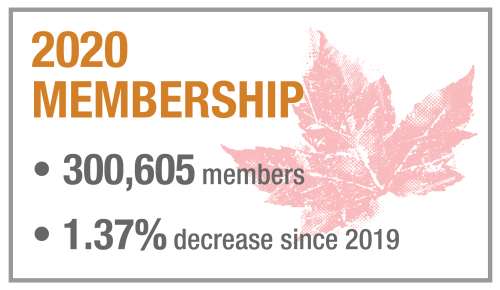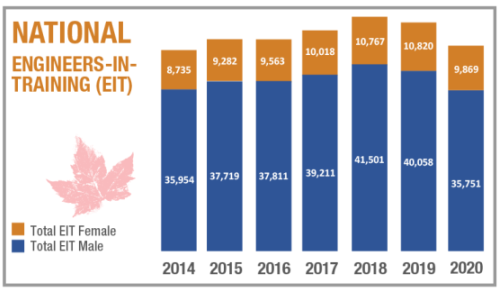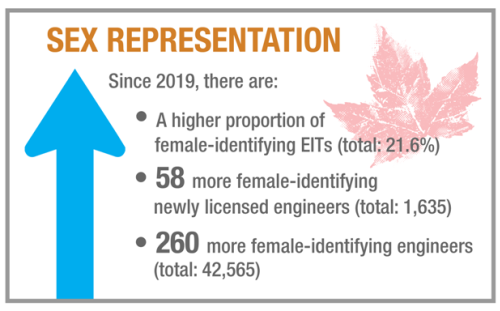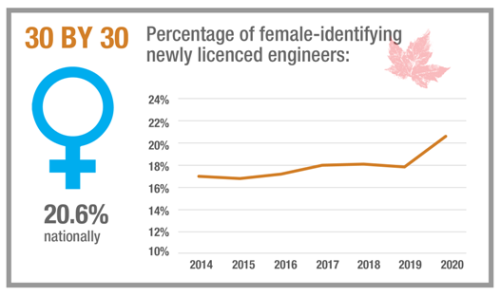Data for 2020
1. Summary
Engineers Canada’s annual National Membership Report collects information from the provincial and territorial engineering regulators about their membership in order to paint a picture of the engineering profession in Canada. The 2021 report captures data from January 1, 2020, to December 31, 2020. Engineering members are categorized based on the definition of practice in each jurisdiction. Please find here all data tables associated with this report.
Overall, there was a slight decrease in licensing and membership. These decreases may be caused by the onset of the COVID-19 pandemic and may indicate certain demographics or regions have been more heavily affected by the impacts of the pandemic. Data presented in this report and future reports will allow us to better understand how global events impact the career trajectories of engineers in Canada.
2. Growth in the engineering profession
 Membership in the provincial and territorial regulators decreased slightly from 2019 to 2020. There were 300,605 members1 as of December 31, 2020, across the 12 engineering regulators comprising the national total membership (see Table 1). This is a decrease of 4,180 members, or a 1.37 per cent decline from the previous year (from 2018 to 2019 there was an increase of 0.8 per cent).2 In 2020, the largest growth in numbers was seen in Alberta (2,242 more members), and the greatest decline was seen in British Columbia (2,773 fewer members).
Membership in the provincial and territorial regulators decreased slightly from 2019 to 2020. There were 300,605 members1 as of December 31, 2020, across the 12 engineering regulators comprising the national total membership (see Table 1). This is a decrease of 4,180 members, or a 1.37 per cent decline from the previous year (from 2018 to 2019 there was an increase of 0.8 per cent).2 In 2020, the largest growth in numbers was seen in Alberta (2,242 more members), and the greatest decline was seen in British Columbia (2,773 fewer members).
3. Newly licensed engineers
 To understand the future of the profession, we track the number of newly licensed engineers3 each year. There were 7,936 newly licensed engineers in 2020, with the largest number (2,545 engineers) obtaining their licence through l’Ordre des ingénieurs du Québec (OIQ) (see Table 2). Nationally, the number of newly licensed engineers decreased between 2019 and 2020, from 8,833 to 7,936. For the seven-year trend in newly licensed engineers (2014 to 2020) see Table 3. Further analysis of the pathway to licensure is captured in the section, ‘Sex representation in engineering.’
To understand the future of the profession, we track the number of newly licensed engineers3 each year. There were 7,936 newly licensed engineers in 2020, with the largest number (2,545 engineers) obtaining their licence through l’Ordre des ingénieurs du Québec (OIQ) (see Table 2). Nationally, the number of newly licensed engineers decreased between 2019 and 2020, from 8,833 to 7,936. For the seven-year trend in newly licensed engineers (2014 to 2020) see Table 3. Further analysis of the pathway to licensure is captured in the section, ‘Sex representation in engineering.’
4. Engineers-in-training
 The number of engineers-in-training (EITs) decreased between 2019 and 2020, by 5,261 members. While the number of EITs decreased for all gender identities, the proportion of female EITs increased from 21.2 per cent to 21.6 per cent. See Table 4 for the national EIT data from 2014 to 2020 (see Table 4).
The number of engineers-in-training (EITs) decreased between 2019 and 2020, by 5,261 members. While the number of EITs decreased for all gender identities, the proportion of female EITs increased from 21.2 per cent to 21.6 per cent. See Table 4 for the national EIT data from 2014 to 2020 (see Table 4).
5. Sex representation in engineering

There are 42,565 female-identifying engineering members, representing 14.2 per cent of total national membership in 2020 (an increase from 13.9 per cent in 2019).4 This is an increase of 260 members who are female-identifying between 2019 and 2020. British Columbia (12.6 to 13.7 per cent) and Yukon (10.3 to 11.7 percent) achieved the largest increases with over one per cent growth from 2019 to 2020.
Engineers Canada and the regulators have been tracking the number of newly licensed female-identifying engineers since 2014, as part of the 30 by 30 initiative. In 2015, Engineers Canada launched the 30 by 30 initiative with support from the provincial and territorial regulators. 30 by 30 is a commitment to increasing the proportion of newly licensed engineers who are women to 30 per cent by 2030.
 This is an important metric for tracking the impact of programs that support gender equity in engineering, since it marks a career milestone for women in their early careers, post-graduation from an accredited program, or for internationally trained engineers entering the Canadian job market.
This is an important metric for tracking the impact of programs that support gender equity in engineering, since it marks a career milestone for women in their early careers, post-graduation from an accredited program, or for internationally trained engineers entering the Canadian job market.
Female-identifying engineers accounted for 20.6 per cent of newly licensed engineers in Canada in 2020 (see Table 2). The total number of female-identifying individuals obtaining their licence between 2019 and 2020 increased from 1,577 (2019) to 1,635 (2020). The number of newly licensed male-identifying engineers decreased between 2019 and 2020, while the number of newly licensed female-identifying engineers remained relatively stable, resulting in a higher proportion of female-identifying engineers.
The largest increases, by region, of newly licensed female-identifying engineers between 2019 and 2020, occurred in Alberta (227 to 284) and Quebec (425 to 499). Newly licensed engineers declined overall by 877 (8,833 in 2019 to 7,936 in 2020) (See Table 3).
Although the number of female-identifying EITs decreased in 2020, the overall proportion increased slightly from 21.2 per cent in 2019 to 21.6 percent in 2020. See Table 4 for the full breakdown of male-and female-identifying EITs.
Engineering student membership also saw an increase in female-identifying members. The representation of engineering student members who identify as female grew from 25.2 per cent to 25.9 per cent between 2019 and 2020.
6. From engineering student to professional engineer
Gathering data on the number of engineering students helps us understand how the engineering profession might grow in the future.
According to Engineers Canada’s Enrolment and Degrees Awarded Report 2015-2019,5 there were 14,905 graduates from accredited post-secondary engineering programs in 2016. Assuming it takes a minimum of four years for a graduate from an accredited engineering program to obtain their professional licence, we can estimate that those 2016 graduates (Cohort A) would be obtaining their engineering licence in 2020 and would be captured in the number of newly licensed engineers in this year’s membership data. Using these figures, we can calculate an estimation of the national conversion from graduation to engineering licensure.
In 2020, CEAB graduates accounted for 5,764, or 72.6 per cent, of the total newly licensed engineers in Canada, which is an increase from 71 per cent in 2019. Based on the number of newly licensed CEAB graduates in 2020, we estimate 38.7 per cent of Cohort A (14,905 graduates) proceeded along the path to licensure.
In 2015, there were 14,113 CEAB graduates (Cohort B). CEAB graduates accounted for 6,290, or 71.2 per cent, of the total newly licensed engineers in 2019. Using the same analysis as above, we can estimate that 44.6 per cent of Cohort B obtained their licensed in 2019.
Therefore, there is a decrease in the proportion of CEAB graduates obtaining their license after four years between Cohort A (2020) and Cohort B (2019). Although this is an estimation, it is an attempt at measuring the successful continuation of engineering students along the pathway to licensure. Given the impact of the global pandemic on the Canadian economy, early career professionals may have experienced a slowing down of their career progression in 2020. As described in section 3, the number of newly licensed engineers decreased between 2019 and 2020, from 8,833 to 7,936, which may be indicative of the pandemic’s impact on early career engineers.
The analysis of graduation to licensure is particularly important in understanding the trend for 30 by 30 and how it relates to the increasing trend of female undergraduate enrolment and graduation. CEAB graduates make up the largest pool of potential engineers, including the largest number of newly licensed engineers who are female-identifying. Breaking down the numbers of Cohort A we see that 2,882 engineering graduates were female-identifying in 2016. In 2020, 1,207 CEAB graduates who are female were newly licensed by the regulators (Table 2). Using the four-year graduate to licensure estimation, we find 41.9 per cent licensure obtainment rate in 2020 for Cohort A who are female-identifying, which is slightly higher than the overall conversion rate for Cohort A (38.7 per cent). The graduate to licensure conversion for male-identifying Cohort A CEAB graduates was 37.9 per cent. Despite the pandemic, female-identifying engineering graduates are continuing on the pathway to licensure at a similar, if not higher, rate as their male-identifying colleagues upon graduation.
To find out more about the 30 by 30 initiative and the 30 by 30 Champions in your province, visit the 30 by 30 webpage.
1. The category, Members, includes Practising P.Eng.’s (exclusive), Temporary License Holders, License to Practise Holders, Restricted License Holders, Non-Practising P.Eng.’s, Life Members and Engineers-in-Training. It does not include students.
2. Engineers Canada, 2020. “2020 National Membership Information.” Engineers Canada, Ottawa, Canada. Available: https://engineerscanada.ca/2020-national-membership-information [Accessed June 10, 2021].
3. The category, Newly Licensed, includes individuals licensed as Professional Engineers for the first time that are Canadian Engineering Accreditation Board trained, Internationally trained, or have obtained their license by some other route. It does not include interprovincial mobility applicants.
4. Sex and gender definition: Sex identifiers have historically been limited to ‘male’ and ‘female’ in the survey of national membership. For the purposes of this survey, data on sex was recorded with three options: “Male”, “Female”, or “Gender Unknown”. We use “female-identifying” to describe participants who selected female, and “male-identifying” to describe participants who selected male, to acknowledge the gender diversity that exists within these sex identities. “Gender Unknown” indicates that the members did not provide a sex identifier
5. Engineers Canada, 2020. “Canadian engineers for tomorrow,” Engineers Canada, Ottawa, Canada. Available: https://engineerscanada.ca/reports/canadian-engineers-for-tomorrow-2019#total-undergraduate-degrees-awarded [Accessed July 13, 2021].
